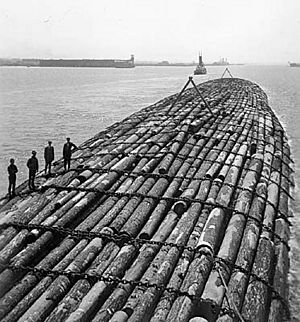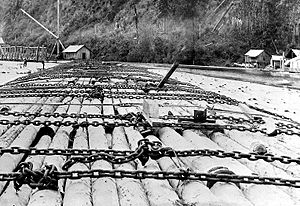Benson raft facts for kids
A Benson raft was a giant floating bundle of logs, like a huge barge made of trees! These rafts were designed to carry massive amounts of timber from places like Oregon and Canada all the way down to Southern California. This clever way of moving logs helped builders in Southern California get wood more cheaply in the early 1900s. It was a big deal for the construction industry back then. The main person who built these unique rafts was John A. Fastaben, hired by Simon Benson. Building these rafts stopped in 1941 after some mysterious fires broke out.
How Benson Rafts Started
Simon Benson, a successful lumber businessman from Portland, Oregon, created the first useful way to move huge amounts of timber across the open ocean. He did this by tying hundreds of logs together into one giant bundle. These huge rafts were then pulled by tugboats from the Columbia River in Oregon, out into the Pacific Ocean, and then about 1,100 miles (1,800 km) south to San Diego, California.
Once in San Diego, the logs were cut into lumber by Benson's company. Most of this wood was sold to builders in San Diego. This whole timber business was very successful for Benson. He saved a lot of money because he didn't have to pay the high costs of shipping timber by railroad. The very first Benson raft was launched in 1906.
John A. Fastabend was the expert Benson hired to gather and put together the logs for these giant rafts. He taught himself how to build these sea-going log rafts. He started building them in 1894 for another company called Robinson Rafting Company. His first raft was built near Stella, Washington, on the Columbia River. It was made of fir logs for building a wharf in San Francisco. This raft was 500 feet (150 m) long and held a lot of wood. But it broke apart after only traveling 30 miles (48 km) into the Pacific Ocean, scattering logs everywhere.
Fastabend tried again the next year, in 1895. This raft was about the same size but was tied together much better with more chains. It stayed together for most of the trip down the California coast. However, just before reaching its destination, it also broke apart.
He didn't give up! Fastabend built a third raft two years later, in 1897. This time, he was successful! The raft of fir logs made it all the way down the California coast to San Francisco without breaking. It arrived safely and earned a great price for its owners. The money they saved on shipping costs almost made up for the losses from the first two failed rafts. He built several more successful rafts for the Robinson Rafting Company over the next few years.
Simon Benson saw Fastabend's success and hired him in 1904 for the Benson Logging Company. Fastabend became their supervisor for building these huge timber rafts. The rafts were built at a place called Wallace slough near Astoria, Oregon. Fastabend usually had about a dozen men working with him. By 1922, when he was 69 years old, he was building five rafts a year and had already built 57 rafts for Benson! These rafts were pulled to San Diego by powerful tugboats. The 112th Benson log raft was launched in 1938, and the last one, the 120th, was launched in 1941.
Out of 120 Benson rafts, only four were lost due to fires or big storms. The very last Benson log raft caught fire for an unknown reason and burned for two days. It then broke apart, sending loose logs into the Pacific Ocean, which was dangerous for other ships. Two other rafts had also broken apart within a year due to mysterious fires. Since only three rafts had caught fire in the previous 34 years, people wondered if someone was purposely causing the fires. Because of these concerns, it was decided to stop building Benson rafts.
How Benson Rafts Were Built
Benson rafts were designed to float like a giant tree trunk. They were made from cut-down trees and held together with huge logging chains.
Building a raft started with a temporary "cradle" made of wood. This cradle looked a bit like the frame of a large wooden ship and was shaped like a cigar. Workers used a special crane called a derrick to place logs into this cradle. This process took about four to seven weeks. They also wove longer timbers through the logs to make the raft stronger and more stable. Large logging chains were then used to tie the whole raft together.
When the raft was finished, one side of the wooden cradle was removed, and the giant raft was launched sideways into the water. Most Benson rafts were about 700 feet (210 m) to 1,000 feet (300 m) long, 55 feet (17 m) wide, and 35 feet (11 m) thick from top to bottom. They usually sat 26 feet (7.9 m) to 29 feet (8.8 m) deep in the water. Each raft could carry between 4,000,000 board feet (9,400 m3) and 8,000,000 board feet (19,000 m3) of logs!
It took about four to six weeks to put together a typical Benson log raft. The assembly used about 125 tons of chain! John Fastabend had a special way of tying the logs together using logging chains and steel cables. This pattern was called a "herring-bone" arrangement. As the logs were placed into the cigar-shaped wooden cradle, they were regularly tightened using special engines called donkey engines. This kept the huge mass of logs very tight as it was being built. This regular tightening of the chains and cables made the raft very strong and stiff, which was important for traveling through ocean currents.
Many Benson sea-going log rafts also carried extra items on top, like fence posts, telephone poles, and finished wood products such as shingles. This was a smart way to save even more money on transportation costs. It's thought that building in Southern California doubled in just four years after cheaper lumber started arriving on Benson rafts. These rafts greatly reduced shipping costs compared to railroads and regular ocean barges. They were the first ever ocean-worthy logging rafts that could carry millions of board feet of timber over long distances across the Pacific Ocean without breaking apart. There was even an idea to use them to ship timber to China, but it seems that never happened.



